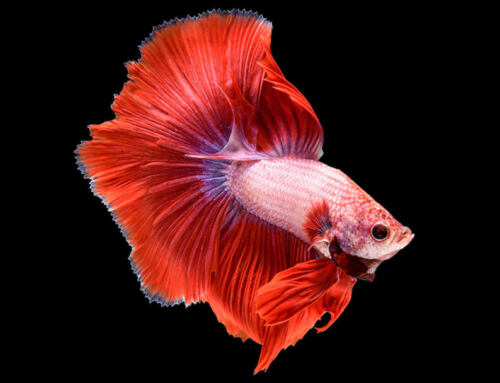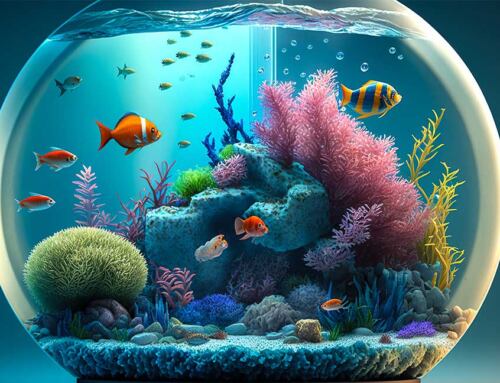The dwarf neon rainbow is perhaps the kind of rainbowfish that is the simplest to maintain. The names Melanotaenia Praecox, Neon Rainbowfish, and Dwarf Rainbowfish are also used to describe it. The dwarf rainbowfish is, without a doubt, the fish for you if you’re an experienced aquarium hobbyist searching for a vibrant and intelligent freshwater small-sized species or if you’re a beginner fish keeper wishing to create your own community tank.
The Dwarf Neon Rainbowfish Melanotaenia praecox is a resilient and adaptable fish after it has been established in the aquarium. This fish is gorgeous and clever, but most of all, it has spirit. If they are kept in good health and happiness, these fish will always be active and amusing. They are highly smart and show a strong awareness of activities taking place outside the tank.
This article contains all the information you need to know about dwarf rainbowfish, including its history, unique care requirements, nutrition, tank mates, and much more.
Neon Dwarf Rainbowfish: What are they?
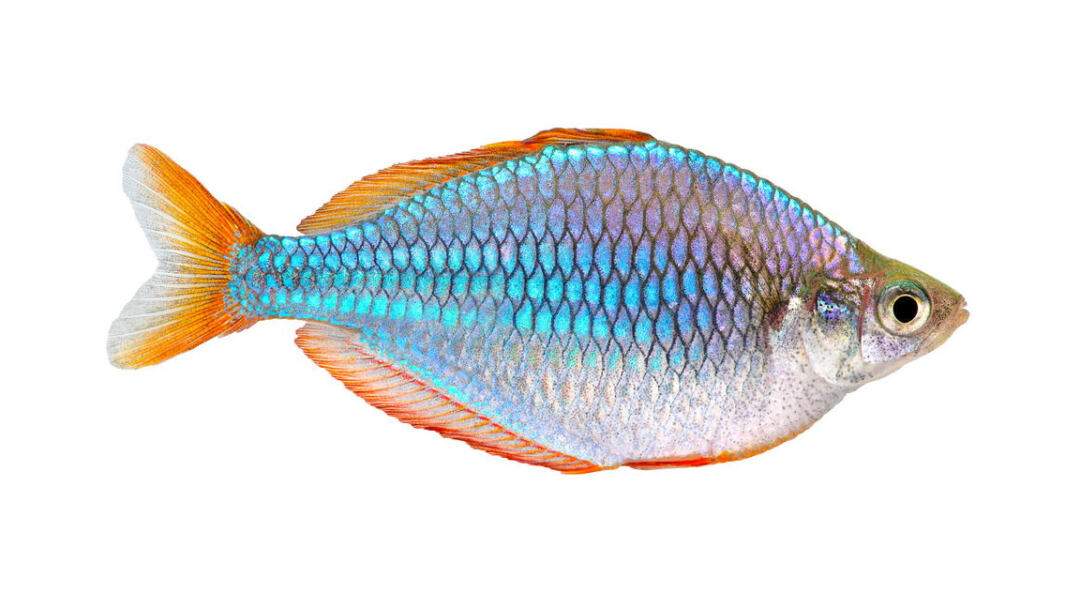
The dwarf neon rainbow, a small freshwater species, is well known for its cunning behavior as a happy school of fish. This fish was initially found in Western New Guinea and Indonesian river basins. They have since become more well-liked due to their compatibility with various community tank configurations. Melanotaenia praecox, a 3-inch (8-cm) rainbowfish, can be found in the streams and tributaries of the New Guinea rainforest. The males have a glossy blue body with reddish-orange fins, while the females have a silvery body with yellow fins. They are among the least expensive Melanotaenia species and range in price from $5 to $7, which is affordable for a rainbow fish.
Dwarf Rainbowfish don’t require much extra care, but due to how poorly they handle stress, they are not recommended for beginners or new aquariums. When working with rainbow fish, there are a few important things to keep in mind. The first is that wild specimens frequently have illnesses and parasites on them. A quarantine period is strongly encouraged prior to introduce new fish. Another thing to keep in mind is that these fish are quite active and do their best in aquariums that are bigger and a little bit longer. All of these fish can jump well, so they closely cover the tank. Maintaining clean water requires regular partial water changes and effective filtration.
Dwarf Neon Rainbowfish Care
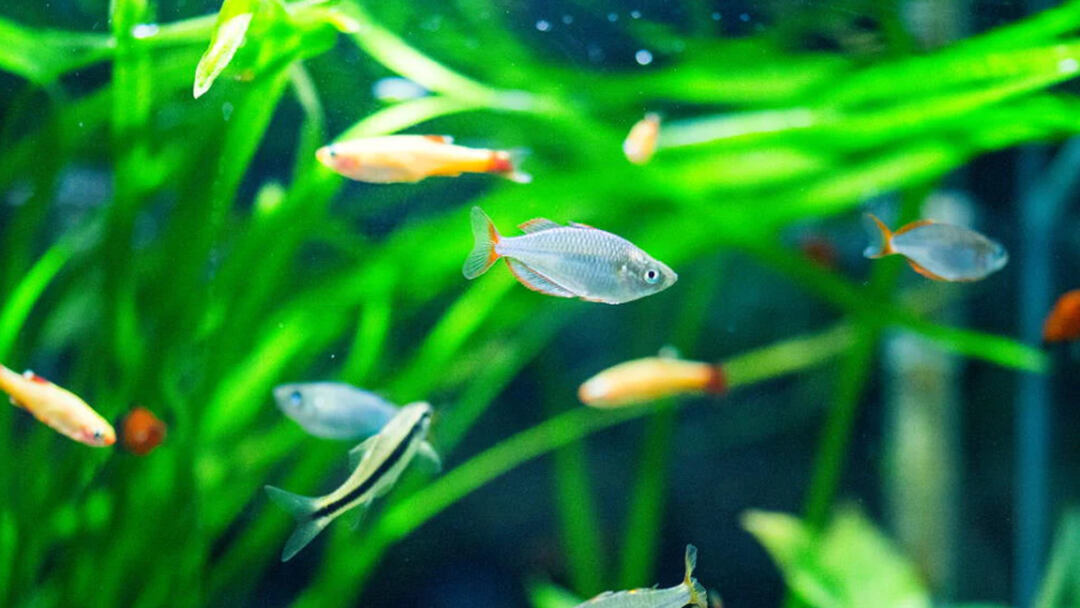
This section contains all the knowledge you need to provide your dwarf neon rainbowfish, also known as a praecox rainbowfish, with the quality of life it deserves. You may discover various tips on healthy Dwarf Neon Rainbow food and nutrition, as well as how to build up an excellent species-specific tank for this type of fish and how to identify and treat some of their common maladies.
Diet
Diminutive neon The rainbow fish is omnivorous, so if you want to keep it happy and healthy, you’ll need to be prepared to feed it a range of nutritious meals. They could begin with fish flakes and pellets, for instance. Make sure the fish flakes or pellets you select are of high quality and small enough to fit in your dwarf rainbowfish’s mouth. You can give your fish this kind of meal once every day, and then you can supplement their diet with a variety of other foods.
Water Parameters
What tools are needed to put together an appropriate Rainbowfish tank? You must first be conscious of the water conditions you must preserve if you want to keep your dwarf neon rainbows happy. It’s crucial to remember that these tiny neon rainbows prefer water temperatures between 72 and 82 degrees Fahrenheit for swimming. The pH of the water should be between 6.5 and 8.0, in addition to maintaining a balanced water hardness level between 5 and 30 dGH. Never forget that this species is restricted to a few water basins and that it prefers slightly more abrasive water than other freshwater fish.
Lifespan
The dwarf neon rainbow can live for an average of three years in a well-kept aquarium. However, your Praecox Rainbowfish can likely survive longer than its typical lifespan if you keep it in a relaxed habitat with enough stimulation, room, and resources to support its growth and immune system. Furthermore, despite their diminutive size, you should find that your dwarf neon rainbows can stay with you for a very long time if you perform weekly water changes, provide premium food, and take care of the other fish in the tank.
Ideal Tank Companions
You can also pair your dwarf neon rainbows with a variety of other fish if you have access to larger aquariums. Tetras, Platys, Guppies, Plecos, Gouramis, Barbs, and other rainbowfish species are some of the ideal tank mates for your Praecox Rainbowfish.
As you may have already noticed, the Praecox Rainbowfish is similar in size and disposition to the aforementioned fish species. It would be preferable to group these fish together if you are a newbie fish keeper and you want to create your first sizable community tank because they are unlikely to bother your Dwarf Neon Rainbows and they will probably complement the silver and blue colors that your Praecox Rainbowfish exhibit.
Avoid Tank Partners
Keep your Praecox Rainbowfish away from large, aggressive, or territorial species like Peacock Bass, Redtail Arowana, Red Tail Shark, or South African Cichlids. Since these fish will only regard your Praecox Rainbowfish as fun prey to pursue around the tank, your Dwarf Neon Rainbows are likely to feel stress for the duration of their time in the community aquarium.
A Guide To Setting Up An Aquarium For Neon Rainbowfish
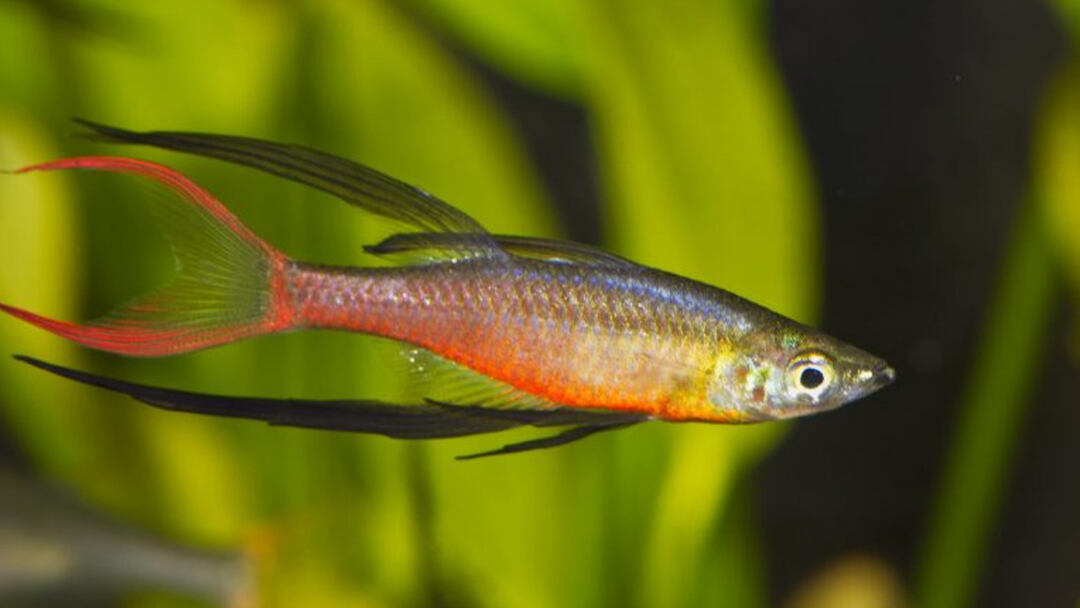
Since they swim quickly, we advise keeping them in a longer aquarium—at the very least, one that is 20 or 29 gallons long. Dwarf neon rainbows thrive in temperatures of 74–80°F (23–27°C) and are native to tropical regions. They are tolerant to a variety of pH and GH levels, but they prefer harder, more alkaline water. We like to use crushed coral for buffering the pH of our relatively soft tap water and mineral supplements (such as Wonder Shell and Seachem Equilibrium) to raise the GH.
Taller plants can assist in blocking the line of sight while the males are fighting each other. Neon fish look fantastic in planted aquariums. Just be careful that the vegetation doesn’t become too overgrown, as rainbowfish prefer to swim freely in open spaces.
How many Praecox rainbows should you try to keep together?
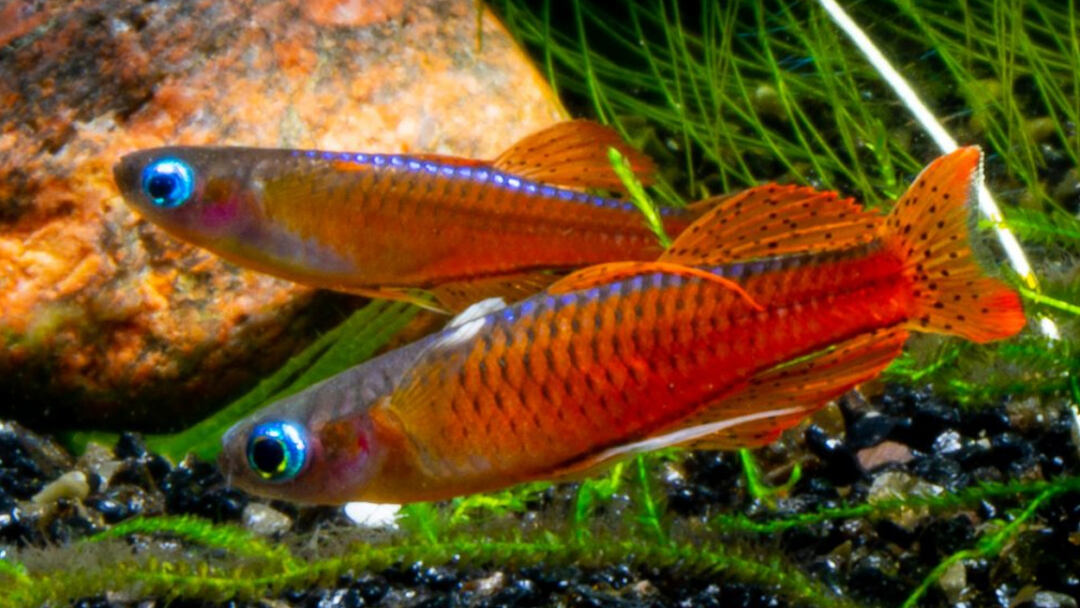
As schooling fish, rainbowfish typically require at least six of the same species, if not more. Despite the fact that females have more subdued colors than males, it is still necessary to have at least one or two females for every male in order to decrease fighting. Men also flaunt their best colors and develop a glossy stripe on their heads when they brag in front of women.
What other fish can you get along with?
Thanks to their deeper-bodied appearance and quick speed, they get along with a wide variety of similarly sized tank mates, ranging from placid to semi-aggressive temperaments. They have been housed with tetras, corydoras catfish, angelfish, pearl gouramis, smaller cichlids, and tetras. Although they seem to avoid the larger Amano shrimp and filter shrimp, they will eat your cherry shrimp.
Breeding
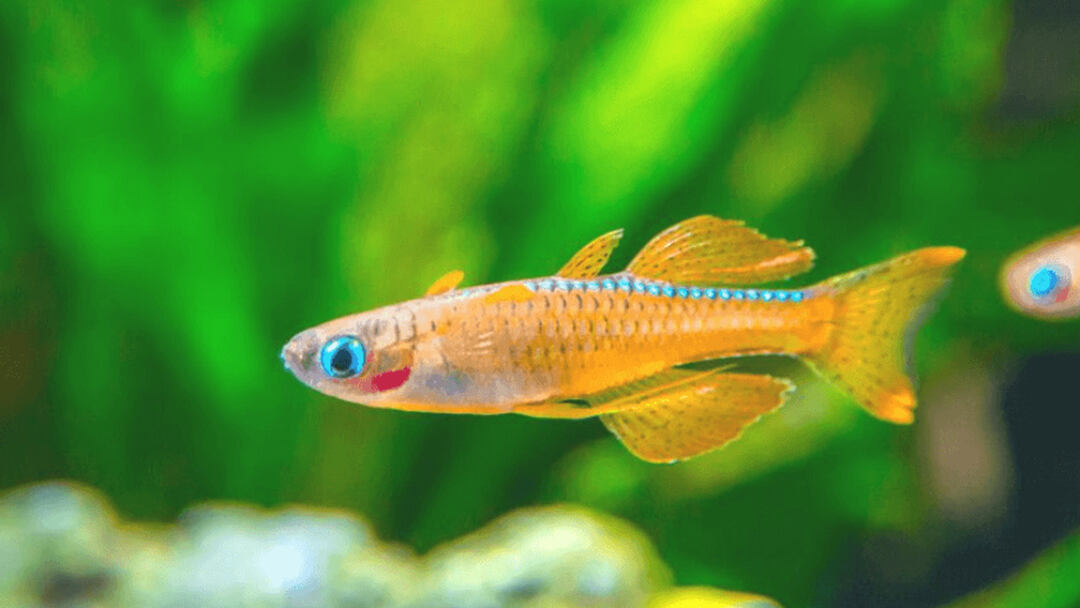
It is recommended to set up a separate, sizable breeding tank with a marble substrate. To provide moderate circulation and filtration, a tiny, air-driven sponge filter (with a mature sponge) should be installed. 26 °C should be chosen as the setting. The breeding tank should next be acclimated by a conditioned group (three females and two males), and it should be filled with lots of Java moss clumps and fine-leaved plants. A male will eventually swim in front of a female and perform for her after a while. Then, using the entire length of the tank, he will start to drive the female over the plants. A few eggs at a time will be dispersed across the plants.
The term “continual spawners” refers to fish whose spawning activity continues for several days, weeks, and occasionally even months. As the eggs are distributed, some adult fish may start consuming them, which can be problematic for the aquarist. But if the grownups are well-fed, this issue might not come up.
Many fishkeepers have learned that the eggs are surprisingly resilient, though. They have had great success siphoning them out into another aquarium with water that matches the spawning tank or else using spawning mops, which, after having caught a number of the eggs, can be moved to a separate tank (again with matching water) and replaced with a new mop, as and when each series of eggs are deposited. The time it takes for the eggs to hatch varies depending on the temperature. The little fry can be fed infusoria once they are swimming freely before moving on to larger meals.
Pre-Breeding Care
The first stage in creating miniature neon rainbow fish is identifying the male and female fish. Prepare your tank so you can breed your dwarf neon rainbows. The breeding tank should have several plants with flat leaves and a soft, fine substrate. Before using, cycle the tank and maintain the water at a temperature of roughly 75 to 80 degrees Fahrenheit.
Introduce your breeding partner to the aquarium and offer them protein-rich foods to entice them to spawn. When your female Praecox Rainbowfish starts to lay clutches of eggs, you should hold off on removing the eggs from the breeding tank until the male has fertilized them.
Keep a watch on the breeding pair and the tank for around one to two weeks; the female Praecox Rainbowfish will continue to lay her eggs in batches. To prevent the breeding pair from eating their own spawn when the eggs are fertilized, remove them all immediately away. Once the dwarf neon rainbow fry has hatched and are being raised in a second hatchery or juvenile fish tank, you can focus on the breeding pair and return them to the primary aquarium.
Post Breeding Care
It should take a week or perhaps ten days for the eggs to hatch. The juvenile fish tank needs to be kept tidy, and its water conditions need to be kept secure and constant. The newly hatched fry will eat infusoria until they are able to swim freely. For your young Praecox Rainbowfish to eat, you can then introduce baby brine shrimp and fish fry flakes.
Conclusion
The dwarf neon rainbow is a highly intelligent fish that will appeal to keepers of all levels. The main topics we discussed in relation to this amazing fish are listed below.
- The dwarf neon rainbow first appeared in the rivers and tributaries of Indonesia and Western New Guinea.
- This kind of fish has a sociable, intellectual attitude and a propensity to school.
- The omnivorous dwarf neon rainbow survives and thrives on a diet that includes frozen meats, processed meals, and fresh leafy vegetables.
- This fish can coexist in a tank with other freshwater fish of the same size and temperament.
- As long as you have healthy breeding couples, a breeding tank, and a separate aquarium in which to rear the fry, the dwarf neon rainbow is simple to breed.
After reading this post, you ought to be able to use what you learned to create a paradise for Praecox Rainbowfish. Use this information as a manual to nurture these lovely freshwater fish in your home with the right care.

